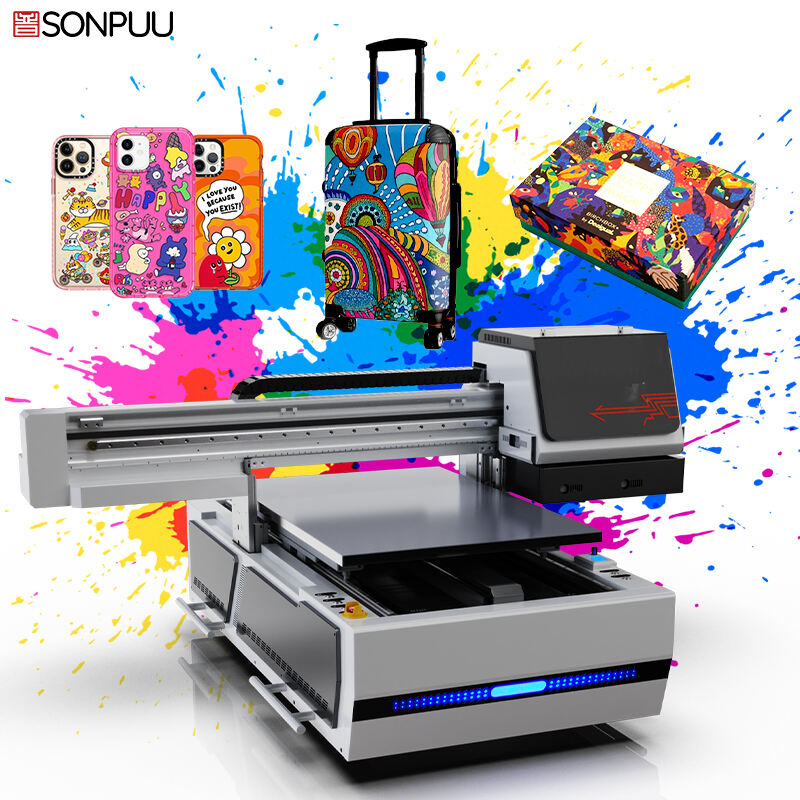Understanding UV DTF Printing and Core Technology
What Is UV DTF Printing and How Does It Work?
UV DTF printing merges direct-to-film transfers with UV curing technology to produce long lasting, detailed designs on tough surfaces. Traditional DTF relies on heat transfer methods, but UV DTF works differently. Specialized printers actually apply UV curable inks directly onto PET film, and these inks solidify almost immediately when exposed to UV light. No waiting around for things to dry anymore, plus colors stay vibrant and true. Once ready, the film with its sticky backing gets pressed against materials such as glass panels, stainless steel appliances, or ceramic tiles. What results are prints that resist scratches and hold up surprisingly well even when exposed to harsh weather conditions outside.
The Role of UV DTF Technology in Modern Digital Printing
The new hybrid tech connects flatbed UV printing with flexible transfer approaches in ways that traditional methods just cant match. These UV DTF printers combine fast UV curing with special adhesive films so they can decorate all sorts of tricky surfaces nobody could reach before. Think about those oddly shaped products or materials sensitive to heat that used to be impossible to print on. Now look at what industries are doing with them across different sectors. Packaging companies create full wraparound cups with edges so sharp they measure down to 0.3mm accuracy. Automotive brands apply metallic logos that actually stand up against harsh chemicals without fading. Even small businesses get their custom promotional stuff printed within three days instead of waiting weeks for results.
From Design to Transfer: The UV DTF Printing Process
- Artwork Preparation: Designers optimize files for layered ink deposition, ensuring proper white underbase coverage
- Film Printing: The printer applies UV resin inks in CMYK + white layers onto adhesive PET film
- Instant Curing: Integrated UV LEDs polymerize inks within seconds, preventing bleeding
- Transfer Application: Users cold-press the cured film onto target substrates using simple roller systems
The process reduces production steps by 40% compared to screen printing while achieving 1200 dpi resolution, making it ideal for intricate designs on promotional products and industrial components alike.
The Science of UV Curing and UV-Curable Inks
How UV-Curable Inks Enhance Print Performance Through Instant Curing
UV curable inks really change how fast we can print because they harden almost instantly when hit with UV light. Because these inks cure right away, printers can crank up quite a bit too. Plus, the colors come out brighter and more solid since less ink gets absorbed and those vibrant colors stay on top where they belong.
The Functionality of Photoinitiators in the Curing Process
UV resin inks have special chemicals called photoinitiators which start a chemical reaction when hit by UV light. This reaction locks the ink in place super quick, preventing it from spreading and keeping details sharp. It creates a polymer layer that’s both flexible and durable enough for things like smart watches or fitness trackers that are worn on the skin
UV Curing vs. Thermal Curing: Performance in DTF Applications
UV curing outperforms thermal curing by hardening inks almost instantly when exposed to UV light. Its benefits include:
- Speed: UV curing is faster, taking seconds compared to several minutes required for thermal curing.
- Versatility: UV curing is effective on materials that are sensitive to heat, such as acrylics and PET films.
- Durability: UV systems maintain consistent performance across various environmental conditions, resist temperature-induced cracking, and reduce energy costs.
Mechanical stress tests show that these prints withstand various conditions making them excellent for industrial and promotional use.
Versatile Applications and Business Opportunities with UV DTF Printers
UV DTF printers excel when printing on intricate designs and unique surfaces like glass, wood, and metal due to the instant curing of UV-cured inks that prevents ink spreading and maintains vibrant color. Their versatility extends to multiple industries, allowing for numerous applications such as car decals and electronic component branding.
Popular Applications for UV DTF Printing
UV DTF printing technology finds its place in various industries, fulfilling diverse needs from creative design to industrial marking:
- Packaging: Full wraparound printed cups, bringing accurate edge-to-edge designs to consumer products.
- Automotive: Durable decal printing for logos and decals that withstand harsh chemicals.
- Promotional Items: Fast production of customized promotional items like laptops and drinkware.
- Retail: Custom product branding for enhanced customer engagement and improved recognition.
FAQ
What types of surfaces can UV DTF printing be applied to?
UV DTF printing can be applied to various surfaces, including glass, metal, wood, ceramics, and even temperature-sensitive materials like acrylics and PET films.
How does UV curing differ from traditional heat-based methods?
UV curing hardens inks almost instantly with UV light, preventing them from spreading and offering sharper detail and more vibrant colors. In contrast, thermal curing takes longer and may result in less color vibrancy because the heat can cause the ink to bleed.
What industries benefit most from UV DTF printing?
UV DTF printing is extremely beneficial across diverse industries, such as automotive, packaging, electronics, and promotional products. It is ideal for creating detailed designs on challenging surfaces.

